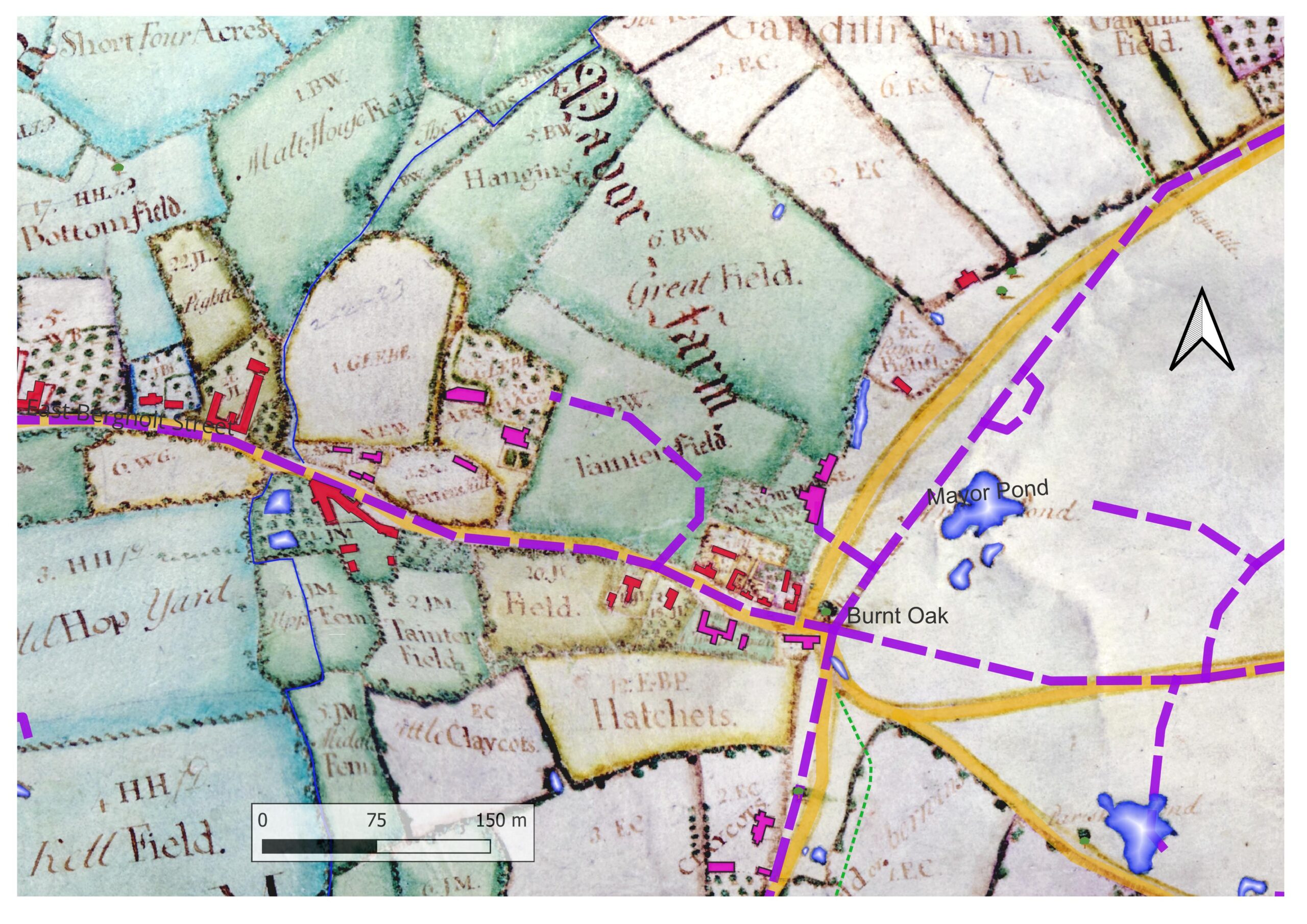Brasier Map of East Bergholt
The Brasier map can be found in the Benneworth Lounge at Constable Hall.
- 66
- William Brasier Map of East Bergholt 1731 as comissioned by Henry Hankey, Lord of the Manor
- 51.969921, 1.025922
Details
East Bergholt in 1731 – The Brasier map
The photograph accompanying this short piece is a very small extract from a map commissioned by Henry Hankey, lord of the manors of Old Hall, Commandre, and Stratford Hall and Spanbies. The surveyor and cartographer was William Brasier, who began his work on the project in 1731 and probably completed the map in 1733. Not a great deal is known about William although there are some other maps by him in existence. The map itself is very big! A slightly enlarged copy of it has been installed, with the kind permission of the Parochial Church Council, in the Benneworth Lounge at the Constable Memorial Hall.
The quality of the cartography is incredible, with stiles, gates, buildings and fences drawn in fascinating detail. The coverage of the map goes beyond the parish of East Bergholt, taking in parts of Stratford St Mary, Higham, Holton St Mary and Brantham. It is known that Henry Hankey, a powerful banking figure, inherited the property owned by John Chaplin, a wine merchant in London, who came from East Bergholt and owned much land in the area. John Chaplin died in 1728 and it is speculated that Henry had the map produced to show his newly acquired properties with, perhaps, a view to expanding his estate further.
In the spring there will be a talk about the map in the Constable Memorial Hall when more will be told, but in the meantime the small extract shown here gives a flavour of what the map can tell us about East Bergholt almost 300 years ago.
Many of the field names shown hark back to the time when the prosperity of the area, like so much of Suffolk, was based on the manufacture of woollen cloth. “Tainter Field” is the name of a place where cloth was stretched out on frames known as tenters. These tenters ensured that the cloth would keep its shape whist drying after washing. There are several such “Tainter Fields” in and around the village.
Some of the farms on the map no longer exist – for example Mayor Farm, which stood where the houses in Gandish Close are today. Peach Cottage is shown on the map overlooking the open expanse of The Heath, which was enclosed in 1817 by act of parliament. However, nowadays it has a row of brick-built cottages blocking the view and standing where the “Burnt Oak” stood. Mr Trotman was running the Kings Head in the early part of the eighteenth century – now known as Oranges and Lemons tea-room.
All the fields and properties have initials that tell us who the owner was or sometimes, the tenant. For example, the fields marked “BW” were owned by Bartholomew Wall Gent. Bartolomew lived in Holton St. Mary and is buried in the church there. He owned the properties shown here as a “copyholder” of the manor of Old Hall. Copyhold was a form of ownership that was almost as strong as freehold, but the copyholder had to carry out certain customs and pay the lord of the manor a small “chief” rent for the property. Copyhold was abolished in the nineteenth century.
Of much interest (to me at least!!) is the large building at the bottom of Rectory Hill, a little east from the present site of Emanuel House. The owner – “JM” – was one Mr James Mitchell who owned, in East Bergholt, 64 acres of land. The schedule alongside the original map tells us that this was a “House, Yards & Orchard”. The man-made ponds west of the house, with their channelled water course perhaps hint that in a former guise, this might have been a fulling mill for the cleansing of woven woollen-cloth to eliminate oils, dirt, and other impurities. Another vestige a rapidly fading industry – even in 1731.
The illustration has certain things shown more boldly – for example, the buildings have been emphasised, as have the streams, ponds and footpaths in 1731. I have also shown the modern roads to help the viewer get their bearings in the map. The aim is to represent each property, field, stile etc. in an electronic format that can be manipulated and analysed to learn more about East Bergholt’s past. My talk in the spring, as mentioned earlier, will reveal more about what is a truly fascinating snapshot into the village’s past. See you there!
Adrian James
Join us on our quest to discover East Bergholt’s past and become a member.
- 66
- William Brasier Map of East Bergholt 1731 as comissioned by Henry Hankey, Lord of the Manor
- 51.969921, 1.025922

